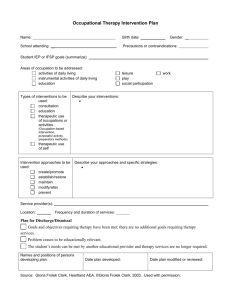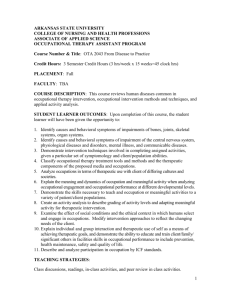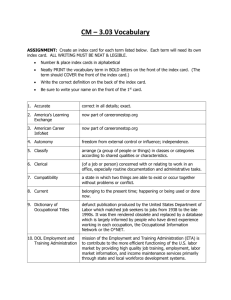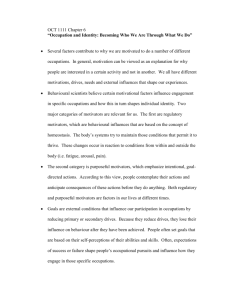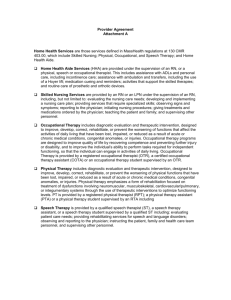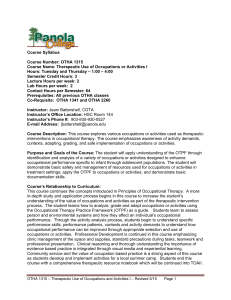Definition of Occupational Therapy Practice for the AOTA Model
advertisement
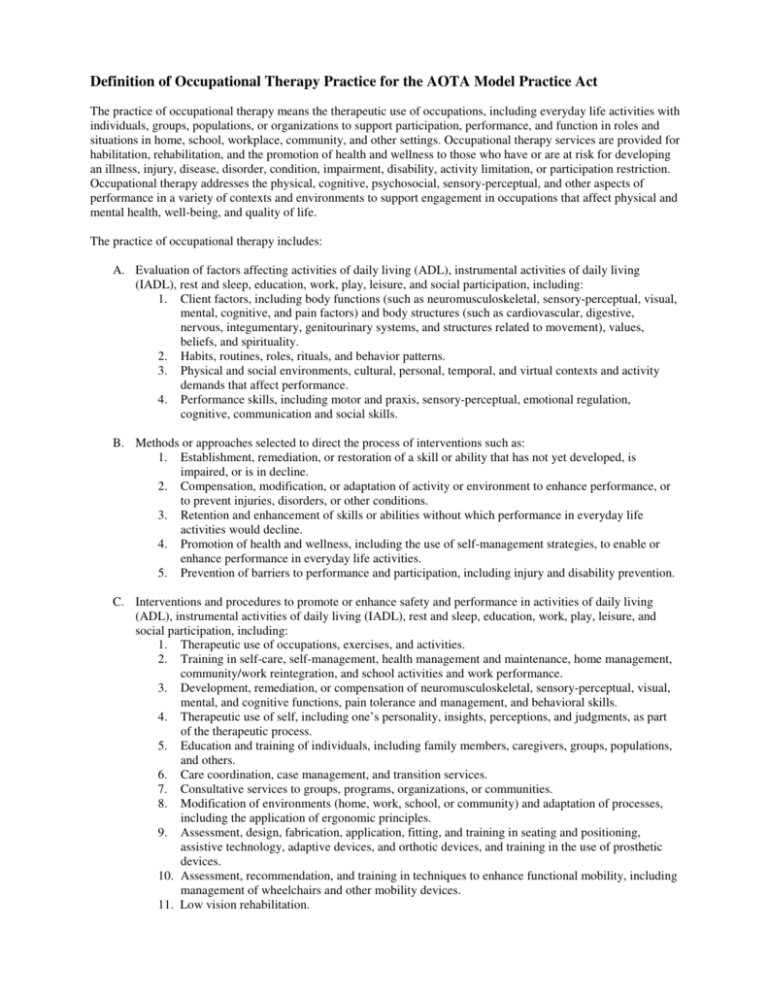
Definition of Occupational Therapy Practice for the AOTA Model Practice Act The practice of occupational therapy means the therapeutic use of occupations, including everyday life activities with individuals, groups, populations, or organizations to support participation, performance, and function in roles and situations in home, school, workplace, community, and other settings. Occupational therapy services are provided for habilitation, rehabilitation, and the promotion of health and wellness to those who have or are at risk for developing an illness, injury, disease, disorder, condition, impairment, disability, activity limitation, or participation restriction. Occupational therapy addresses the physical, cognitive, psychosocial, sensory-perceptual, and other aspects of performance in a variety of contexts and environments to support engagement in occupations that affect physical and mental health, well-being, and quality of life. The practice of occupational therapy includes: A. Evaluation of factors affecting activities of daily living (ADL), instrumental activities of daily living (IADL), rest and sleep, education, work, play, leisure, and social participation, including: 1. Client factors, including body functions (such as neuromusculoskeletal, sensory-perceptual, visual, mental, cognitive, and pain factors) and body structures (such as cardiovascular, digestive, nervous, integumentary, genitourinary systems, and structures related to movement), values, beliefs, and spirituality. 2. Habits, routines, roles, rituals, and behavior patterns. 3. Physical and social environments, cultural, personal, temporal, and virtual contexts and activity demands that affect performance. 4. Performance skills, including motor and praxis, sensory-perceptual, emotional regulation, cognitive, communication and social skills. B. Methods or approaches selected to direct the process of interventions such as: 1. Establishment, remediation, or restoration of a skill or ability that has not yet developed, is impaired, or is in decline. 2. Compensation, modification, or adaptation of activity or environment to enhance performance, or to prevent injuries, disorders, or other conditions. 3. Retention and enhancement of skills or abilities without which performance in everyday life activities would decline. 4. Promotion of health and wellness, including the use of self-management strategies, to enable or enhance performance in everyday life activities. 5. Prevention of barriers to performance and participation, including injury and disability prevention. C. Interventions and procedures to promote or enhance safety and performance in activities of daily living (ADL), instrumental activities of daily living (IADL), rest and sleep, education, work, play, leisure, and social participation, including: 1. Therapeutic use of occupations, exercises, and activities. 2. Training in self-care, self-management, health management and maintenance, home management, community/work reintegration, and school activities and work performance. 3. Development, remediation, or compensation of neuromusculoskeletal, sensory-perceptual, visual, mental, and cognitive functions, pain tolerance and management, and behavioral skills. 4. Therapeutic use of self, including one’s personality, insights, perceptions, and judgments, as part of the therapeutic process. 5. Education and training of individuals, including family members, caregivers, groups, populations, and others. 6. Care coordination, case management, and transition services. 7. Consultative services to groups, programs, organizations, or communities. 8. Modification of environments (home, work, school, or community) and adaptation of processes, including the application of ergonomic principles. 9. Assessment, design, fabrication, application, fitting, and training in seating and positioning, assistive technology, adaptive devices, and orthotic devices, and training in the use of prosthetic devices. 10. Assessment, recommendation, and training in techniques to enhance functional mobility, including management of wheelchairs and other mobility devices. 11. Low vision rehabilitation. 12. Driver rehabilitation and community mobility. 13. Management of feeding, eating, and swallowing to enable eating and feeding performance. 14. Application of physical agent modalities, and use of a range of specific therapeutic procedures (such as wound care management; interventions to enhance sensory-perceptual, and cognitive processing; and manual therapy) to enhance performance skills. 15. Facilitating the occupational performance of groups, populations, or organizations through the modification of environments and the adaptation of processes. Adopted by the Representative Assembly 4/14/11 (Agenda A13, Charge 18)
